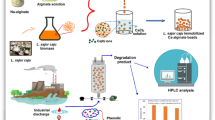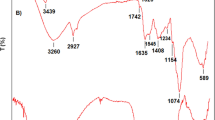Abstract
The main objective of this work was to investigate the removal of aqueous phenol using immobilized enzymes in both bench scale and pilot scale three-phase fluidized bed reactors. The enzyme used in this application was a fungal tyrosinase [E.C. 1.14.18.1] immobilized in a system of chitosan and alginate. The immobilization matrix consisted of a chitosan matrix cross-linked with glutaraldehyde with an aliginate-filled pore space. This support matrix showed superior mechanical properties along with retaining the unique adsorptive characteristics of the chitosan. Adsorption of the o-quinone product by the chitosan reduced tyrosinase inactivation that is normally observed for this enzyme under these conditions. This approach allowed reuse of the enzyme in repeated batch applications. For the bench scale reactor (1.2-l capacity) more than 92% of the phenol could be removed from the feed water using an immobilized enzyme volume of 18.5% and a residence time of the liquid phase of 150 min. Removal rates decreased with subsequent batch runs. For the pilot scale fluidized bed (60 l), 60% phenol removal was observed with an immobilized enzyme volume of 5% and a residence time of the liquid phase of 7 h. Removal decreased to 45% with a repeat batch run with the same immobilized enzyme.








Similar content being viewed by others
References
Karam J, Nicell JA (1997) Potential applications of enzymes in waste treatment. J Chem Tech Biotechnol 69:141–153
Flock C, Bassi A, Gijzen M (1999) Removal of aqueous phenol and 2-chlorophenol with purified soybean peroxidase and raw soybean hulls. J Chem Tech Biotech 74:303–309
Caza N, Bewtra JK, Biswas N, Taylor KE (1999) Removal of phenolic compounds from synthetic wastewater using soybean peroxidase. Wat Res 33:3012–3018
Seetharam GB, Saville, BA (2003) Degradation of phenol using tyrosinase immobilized on siliceous supports. Wat Res 37:436–440
Vamos-Vigyazo L (1981) Polyphenol oxidase and peroxidase in fruits and vegetables. CRC Crit Rev Food Sci Nutr 15:49–127
Meyer A, Harel E (1991) Polyphenoldoxidases and their significance in fruit and vegetables. Food Enzymology, Ch 9. Elsevier, London, pp 373–398
Ikehata K, Nicell JA (2000) Color and toxicity removal following tyrosinase-catalyzed oxidation of phenols. Biotech Prog 16:533–540
Wu Y, Taylor KE, Biswas N, Bewtra JK (1999) Kinetic model for removal of phenol by horseradish peroxidase with PEG. J Environ Eng 125:451–458
Ibrahim MS, Ali HI, Taylor KE, Biswas N, Bewtra JK (2001) Enzyme-catalyzed removal of phenol from refinery wastewater: Feasibility studies. Water Environ Res 73:165–172
Sun WQ, Payne F (1996) Tyrosinase-containing chitosan gels: a combined catalyst and sorbent for selective phenol removal. Biotech Bioeng 51:79–86
Juang R-S, Wu F-C, Tseng R-L (2002) Use of chemically modified chitosan beads for sorption and enzyme immobilization. Adv Environ Res 6:171–177
Cetinus SA, Öztop HN (2003) Immobilization of catalase into chemically crosslinked chitosan beads. Enzyme Microb Tech 23:889–894
Edwards W, Leukes WD, Rose PD, Burton SG (1999) Immobilization of polyphenol oxidase on chitosan-coated polysulphone capillary membranes for improved phenolic effluent bioremediation. Enzyme Microb Tech 25:769–773
Payne F, Sun WQ (1994) Tyrosinase reaction and subsequent chitosan adsorption for selective removal of a contaminant from a fermentation recycle stream. Appl Environ Microbiol 60:397–401
Wada S, Ichikawa H, Tatsumi K (1995) Removal of phenols and aromatic amines from wastewater by a combination treatment with tyrosinase and a coagulant. Biotech Bioeng 45:304–309
Ikehata K, Nicell JA (2000) Characterization of tyrosinase for the treatment of aqueous phenols. Bioresource Tech 74:191–199
Worthington Biochemical Corp. (1972) Worthington enzyme manual. Freehold, New Jersey
Taticek RA, Moo-Young M, Legge RL (1990) Effect of bioreactor configuration on substrate uptake by cell suspension cultures of the plant Eschscholtzia californica. Appl Microbiol Biotechnol 33:280–286
Sun W-Q, Payne GF, Moas M, Chu JH, Wallace KK (1992) Tyrosinase reaction/chitosan adsorption for removing phenols from wastewater. Biotech Prog 8:179–186
Shishido M, Kojima T, Araike Y-K, Toda M (1995) Biological phenol degradation by immobilized activated sludge in gel bead with three-phase fluidized bed bioreactor. Chemical Engineering Research and Design, Trans Insti Chem Eng 73(A):719–726
Alvarez-Cuenca M, Nerenberg MA, Asfour AA (1984) Mass transfer effects near the distributor of three-phase fluidized bed. Ind Eng Chem Fundamentals 23:381–386
Acknowledgements
The experimental work presented herein is the result of the academic agreement between Ryerson University and the University of Cartagena de Indias (Colombia) and the collaboration of the Departments of Chemical Engineering of Ryerson University (Toronto) and the University of Waterloo (Waterloo). RLL acknowledges support of this work in the form of a Discovery Grant from NSERC.
Author information
Authors and Affiliations
Corresponding author
Rights and permissions
About this article
Cite this article
Ensuncho, L., Alvarez-Cuenca, M. & Legge, R.L. Removal of aqueous phenol using immobilized enzymes in a bench scale and pilot scale three-phase fluidized bed reactor. Bioprocess Biosyst Eng 27, 185–191 (2005). https://doi.org/10.1007/s00449-005-0400-x
Received:
Accepted:
Published:
Issue Date:
DOI: https://doi.org/10.1007/s00449-005-0400-x




